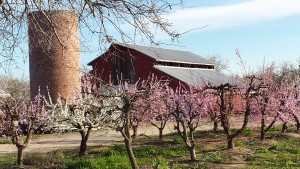Blossoms, blossoms, blossoms. Everywhere I look I see delicate buds bursting into full bloom. Pink blossoms appear surreal against the blue sky. White blossoms cover the ground like snow. No matter the color they’re simply stunning.
When I drive my car or ride my bike alongside miles of blooming trees they seem to blend together and appear the same. But on closer look the trees are not alike. Yes, they may be all almond trees or cherry trees, but the trees display differences.
When I take snapshots of blossoming trees at stoplights or jump off my bike to photograph a glimpse of spring I can clearly see the differences. My macro lens captures God’s minuet blossom designs.
Blossom Differences
Some trees are loaded with blossoms. It appears spring arrived early for these trees laden with heavy braches. I imagine the trees producing an abundance of food.
And then there are the ordinary or typical blossoming trees. They aren’t loaded with blossoms. Evidence of blossoms appears on most every branch. I’m not an agriculturalist, but I imagine some might say, “This is what normal almond trees [or cherry trees] look like.”
 Perhaps other trees were notified late that spring is here. Their branches are just beginning to display sporadic blossom clusters. Eventually the tree will become full of blooms, just later than the already fully blooming trees.
Perhaps other trees were notified late that spring is here. Their branches are just beginning to display sporadic blossom clusters. Eventually the tree will become full of blooms, just later than the already fully blooming trees.
Types of Adolescent Blossoms
These three types of blossoming trees remind me of adolescents’ physical development. Some adolescents blossom early. They’re in full bloom long before their peers. Some happily bloom, while others bemoan their early blossoms.
And then there are adolescents whose blossoms are not abundant nor are they just beginning to bloom. Their blossoms match growth charts for typical or normal development.
Finally, there are adolescents who bloom much later than their peers. While some peers are in full bloom these adolescents are just peeking at adolescence. They are just beginning to bloom which is why they’re often called late bloomers.
Parents and Their Blossoming Kids
How do parents cope with their blossoming adolescents? My husband and I are among the few parents who looked forward to our daughters’ adolescence. We both possess years of experience with youth and understand that adolescence is synonymous with change, not only for adolescents but for parents as well. Watching our daughters bloom into who God created them to be provided countless milestones to celebrate with them.
Fear and Dread
However, the majority of parents dread their child’s adolescence like the plague. Parents say, “I’m scared. I hear so many horror stories. I wish I could just protect them and keep them little.”
Realizing they can’t keep their kids from growing up, they believe they can deter challenges by keeping their kids super busy. Their reasoning is, “If my kids’ days are spent doing homework, club activities and playing sports they can avoid pitfalls and negative influences.”
Over-controlling
A small group of parents are extremely uncomfortable with their adolescents’ physical changes and respond by over-controlling everything their child does. They fear potential possibilities, like choosing sexual activity, becoming pregnant or getting someone pregnant, or getting an incurable STI (Sexually Transmitted Infection). In reality this strategy often backfires resulting in more challenges than if they’d helped their kids face adolescence in a healthy way.
Hush-Hush
Parents who are overly religious or ultra conservative are particularly susceptible to making sexual development seem evil, and sex as something to avoid. They treat the naughty topic as a hush-hush. But today’s 21st century kids know better than that.
God’s Ideal
The ideal is for adolescents to be aware of their maturing sexuality, to feel good about it, and to gradually develop meaningful relationships with the other sex. They need to know that their body changes are a gift from God that will ultimately culminate in sexual intimacy with their future spouse.
Suggestions for Parents
Here are some suggestions to help parents positively deal with adolescents’ changing physical development. Parents need to provide accurate information before adolescents begin blossoming. If parents renege on this responsibility, what will children learn from others? Will it represent parents’ values and beliefs?
Adolescents need assurance that their changing bodies are a “normal” part of growing up. They need encouragement and freedom to talk about their changing bodies, express their fears and ask questions. If parents aren’t available, where will they find answers and acceptance?
Parents may become paler than the white spring blossoms if they dare to bring up the subject of body changes. They may blush the color of pink blossoms. But it’s not too late to accurately teach pre-adolescents about their changing bodies. No one can communicate the information with their values as well as parents.
Helpful Resources
Fortunately, there are many resources for parents who are uncomfortable or uncertain about how to approach their children’s physical development. For help on teaching healthy sexual development refer to my resource list for both adolescents and parents at https://fromdiaperstodiamonds.com/writing/resources/.
